Kinsta is a well-known, highly performant hosting platform built on top of the Google Cloud. While we’re not the only hosting provider leveraging Google’s infrastructure, we’re the only one that puts its customers on the fastest virtual machines available in each of the 37 Google data centers where our servers are located.
Earlier in 2024, we migrated all our Managed WordPress Hosting customers to Google’s recently released C3D machines in all data centers where these faster VMs were available. This was the most significant upgrade to that cloud’s computing hardware since we adopted Google’s compute-optimized C2-based VMs in 2019.
The C2s were then the fastest machines available for web hosting and brought a huge performance boost to the Kinsta platform. In fact, the C2 is still the fastest machine in most Google data centers. We will move customers to C3D VMs in more data centers when Google makes them available.
Before rolling out C3D machines to Kinsta customers, we conducted lab-based testing that promised real-world improvements in server response times of up to 50%.
Below, we look at numbers from some tests using actual WordPress sites.
What’s new in Google’s C3D machines?
You can read our in-depth look at the C3D technology, but two features in particular have dramatic impacts on VM performance:
- A fourth-generation AMD EPYC CPU (formerly codenamed “Genoa”) that can operate at a frequency of 3.7 GHz and supports up to 360 virtual CPUs and 2,880 GB of DDR5 memory.
- An Infrastructure Processing Unit (IPU) that boosts networking performance and data I/O while freeing the CPU from those tasks.
On this platform, server-side code is interpreted faster, databases are speedier, and data moves in and out of network interfaces at greater rates. For example, during our earlier lab testing, a MySQL/MariaDB stress test saw the time lag for responses to database requests drop from 89 milliseconds on C2 machines to 0.9 milliseconds on a C3D machine.
WordPress sites hosted at Kinsta are ready to take advantage of such power because each one runs in a container isolated from other sites and includes all supporting software, like Linux, NGINX, PHP, and MariaDB.
VM performance comparisons
To compare the performance of the C3D-based VM with other classes of machines, we created three identical WordPress (v6.5) websites: one on a C3D machine, one on a C2, and another on one of the N2 machines still available in a couple of data centers. (Although the use of N2 machines is not heavy at Kinsta, many other hosts use them, so we included this comparison to help you visualize the impact you’d have on your site’s performance just by moving to Kinsta.)
This was the Kinsta WordPress Hosting environment common to all three sites:
- WordPress version 6.5
- PHP version 8.2
- Ubuntu version 20.04.6
- NGINX web server version 1.25.2
- MariaDB version 15.1
To simulate heavy loads on our test sites, we used the Apache ab HTTP server benchmarking tool, which is capable of emulating multiple concurrent users making many page requests.
Requesting uncached content
We wanted to see how the three VMs compared when delivering content that bypassed the on-server caching mechanisms — particularly the page cache. The identical sites’ WooCommerce shopping carts were the perfect targets for these tests since they are coded to request a cache bypass on the server.
Without cached content, WordPress must query the database and build the target page on every request. That’s not efficient, but it’s often necessary when the content is unique to an individual site visitor — like the contents of a shopping cart.
On all three of our test sites, the default shopping cart view generated a 235-KB HTML page.
So, our Apache ab testing protocol was like this:
- Page size: 235 KB
- Simulated concurrent users: 50
- Run time: 60 seconds
The results (successful requests per second):
- C3D: 207.72
- C2: 141.47
- N2: 89.93
Takeaway: The C3D VM served an average of 46.8% more uncached pages than the twin site on the C2.
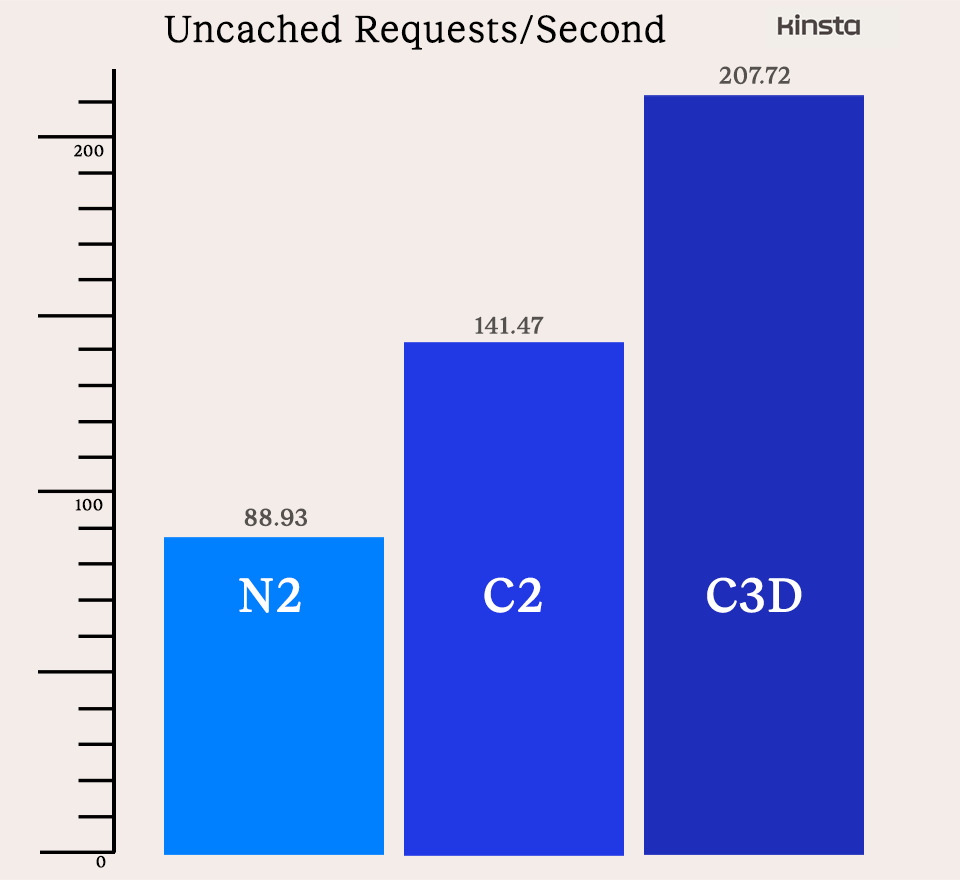
Requesting cached content
With caching enabled, our WordPress sites can deliver pages without having to launch PHP workers and query the database. In fact, with NGINX’s in-memory cache, some compiled content doesn’t even have to be read from disk.
Our cachable test content was an identical blog post on each site that weighed in at 114 KB, so our Apache ab testing protocol was like this:
- Page size: 114 KB
- Simulated concurrent users: 50
- Run time: 60 seconds
The results (successful requests per second):
- C3D: 19,722.58
- C2: 13,043.27
- N2: 7,861.23
Takeaway: The C3D VM, with its improved I/O, really stood out here when moving much more content faster than the other machines. The C3D site delivered 51.2% more cached pages than the C2 machine.
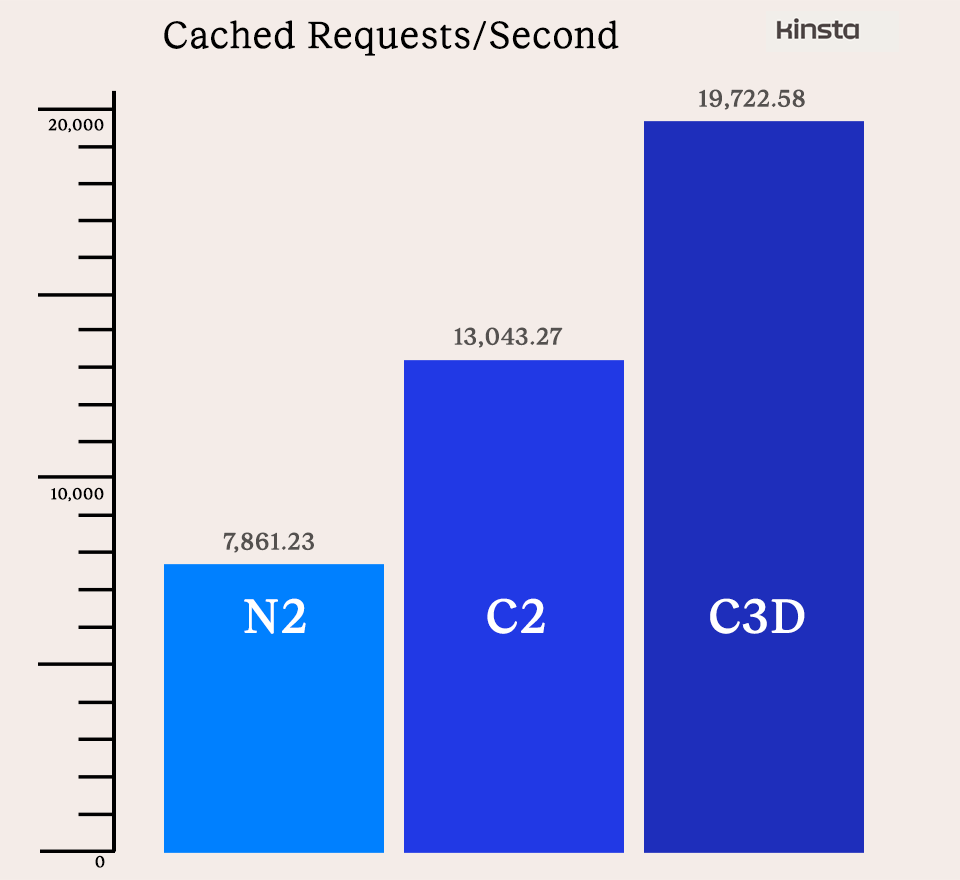
An example of raw processing power
We used image manipulation to test processing on our VMs that wasn’t directly related to delivering web pages — although resizing image uploads and making copies with different dimensions is standard procedure for many WordPress sites.
We used the ImageMagick extension in PHP to downsize a 35 MB JPEG image to approximately 29 KB (from 7,362 x 4,702 pixels to 640 x 408 pixels) using that software’s resizeImage() function and the Bessel filter.
The resulting average processing times:
- C3D: 1.484 seconds
- C2: 2.090 seconds
- N2: 2.305 seconds
Takeaway: While resizing of the image was relatively speedy on all of our test platforms, the C3D machine completed the task nearly 30% faster than the C2 machine:
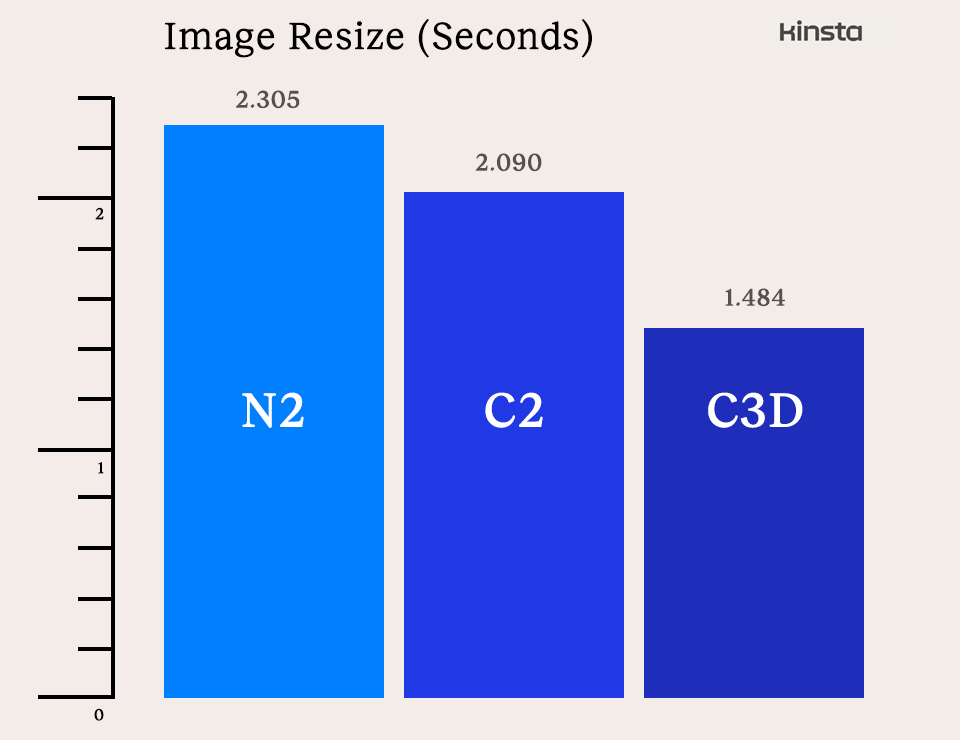
No C3Ds in your data center? Not a problem!
The C3Ds offer clear advantages to operators of WordPress websites. In particular, if your site generates content that can’t be cached, you might consider if those advantages make it worthwhile to house it in one of the data centers supporting these new machines.
If much of your website’s content is cachable, those pages are candidates for global distribution through Kinsta’s free Edge Caching, one of the services included in our Cloudflare integration.
Edge caching may be the best performance solution for Kinsta customers who must locate their sites in a country where faster VMs are unavailable.
With edge-cachable content distributed throughout Cloudflare’s data centers worldwide, response times for websites on our C3D, C2, and N2 test machines were practically identical when measured by time to first byte (TTFB) from various external locations.
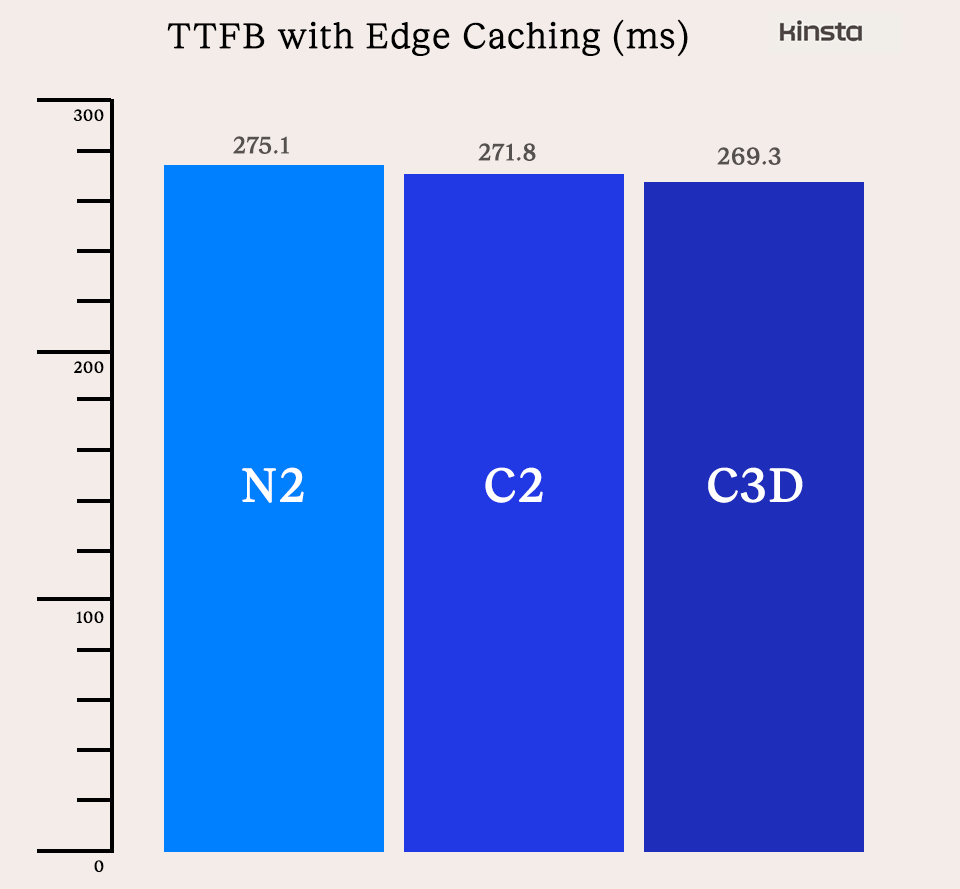
Even with Edge Caching, average response speed over time can be slightly faster with the C3D machines since sites hosted on them may populate and refresh caches quicker.
Where can you find C3D machines?
Currently, C3D machines are available in the following 6
Google Cloud data centers:
- Jurong West, Singapore (asia-southeast1)
- St. Ghislain, Belgium (europe-west1)
- Eemshaven, Netherlands (europe-west4)
- Council Bluffs, Iowa, USA (us-central1)
- Moncks Corner, South Carolina, USA (us-east1)
- Ashburn, Virginia, USA (us-east4)
Within the MyKinsta dashboard, regions with the C3D machines enabled are labeled as Boosted in the Data center location drop-down when adding a new WordPress site:
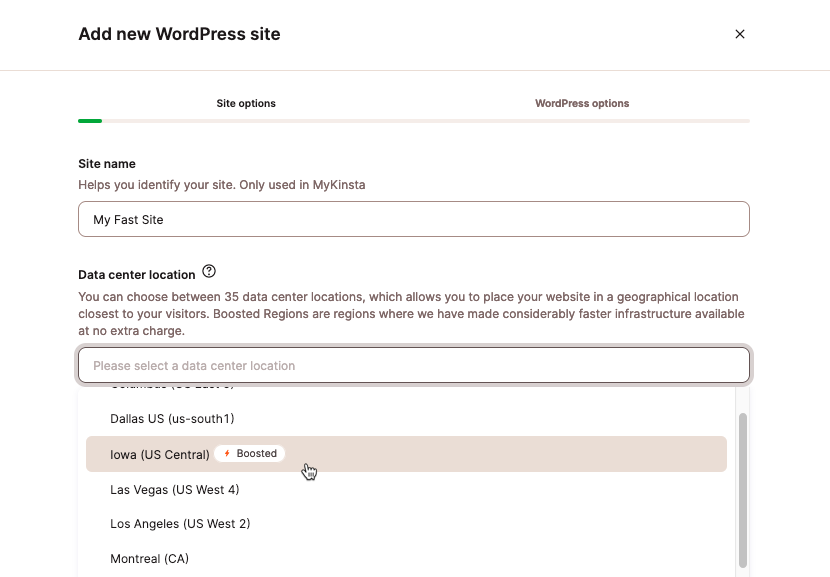
If you have an existing site in a data center where Google has not yet made C3D machines available, you can contact Support to request a move to a C3D data center.
For now, Google’s compute-optimized C2 VMs are the top performers in these data centers:
- Changhua County, Taiwan (asia-east1)
- Hong Kong (asia-east2)
- Tokyo, Japan (asia-northeast1)
- Osaka, Japan (asia-northeast2)
- Seoul, South Korea (asia-northeast3)
- Mumbai, India (asia-south1)
- Delhi, India (asia-south2)
- Jakarta, Indonesia (asia-southeast2)
- Sydney, Australia (australia-southeast1)
- Melbourne, Australia (australia-southeast2)
- London, United Kingdom (europe-west2)
- Frankfurt, Germany (europe-west3)
- Zurich, Switzerland (europe-west6)
- Montréal, Canada (northamerica-northeast1)
- Toronto, Canada (northamerica-northeast2)
- São Paulo, Brazil (southamerica-east1)
- Columbus, Ohio, USA (us-east5)
- The Dalles, Oregon, USA (us-west1)
- Los Angeles, California, USA (us-west2)
- Salt Lake City, Utah, USA (us-west3)
- Las Vegas, Nevada, USA (us-west4)
Summary
Our testing suggested that moving to Google’s new, faster C3D VMs could benefit many website owners, particularly those whose sites deliver content that can’t be cached.
Compared to just our C2 machines — previously the fastest available for web hosting in Google’s data centers — the C3Ds showed:
- A performance improvement of nearly 47% in uncached page requests
- An improvement of approximately 52% in cached page requests
- A 30% improvement in processing time for a task like resizing images
Remember: Lightning-fast VMs aren’t the only thing Google Cloud brings to Kinsta hosting. We also take advantage of Google’s low-latency Premium Tier network.
In addition to its role in Edge Caching, Cloudflare is behind our super-fast CDN, code minification, early hints, and image optimization.
Find a Managed WordPress Hosting package here at Kinsta that’s right for you.
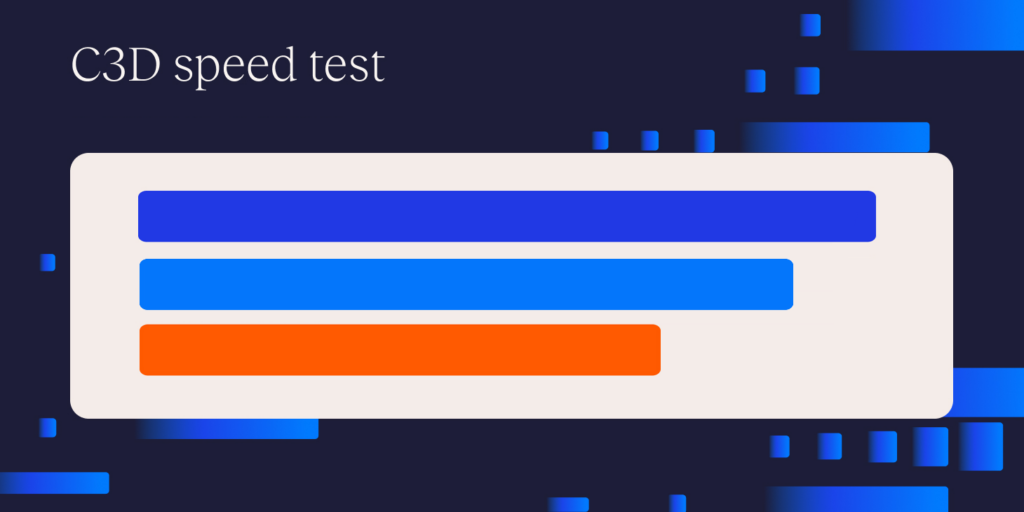


Leave a Reply